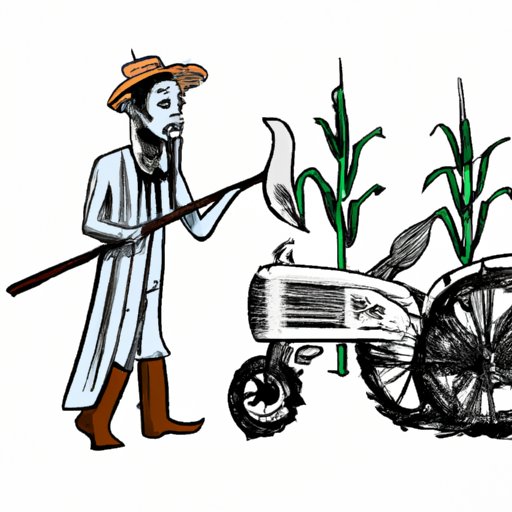Introduction
The reaper is one of the most important inventions in agricultural history, revolutionizing the way farmers worked and ultimately leading to the development of industrial agriculture. But who was the ingenious mind behind this game-changing invention? The answer is Cyrus McCormick, an American inventor and businessman from Virginia who created the first mechanical reaper in 1831.
A Biographical History of the Reaper’s Inventor
Cyrus McCormick was born in 1809 in Rockbridge County, Virginia to Robert and Mary McCormick. His father was an industrious farmer who had tried and failed to develop a reaping machine of his own. While growing up on the family farm, Cyrus developed an interest in mechanics, and decided to build upon his father’s work by inventing a successful reaping machine.
In 1831, after several years of tinkering, Cyrus finally succeeded in creating a working model of the reaper. He received a patent for the invention in 1834 and soon began manufacturing the machines. He set up the first factory in Chicago in 1847, and opened several other factories in the Midwest shortly thereafter. By the late 1850s, McCormick’s business was thriving, and the reaper had become a staple of American agriculture.
How the Reaper Changed Farming Practices
Before the invention of the reaper, harvesting crops was a laborious process that required large numbers of manual laborers. This made farming inefficient and expensive, and limited the amount of land that a farmer could work. The reaper changed all this, allowing a single farmer to do the work of dozens of laborers in far less time. This increased efficiency allowed farmers to work more land and produce larger yields.
The reaper also allowed for the mechanization of many other aspects of farming, such as planting and threshing. As a result, farms became much more efficient, and productivity increased significantly. This led to the rise of industrialized agriculture, which allowed farmers to produce food more cheaply and efficiently than ever before.
A Timeline of the Reaper’s Development
Cyrus McCormick’s journey to invent the reaper was a long and arduous one. He started work on the invention in 1831, and spent the next several years perfecting the design. In 1834, he received a patent for the reaper, and began manufacturing the machines in 1847. By the 1850s, the reaper had become a staple of American agriculture, and McCormick’s business was booming.
McCormick continued to improve the design of the reaper throughout his lifetime. In 1858, he introduced the self-rake reaper, which allowed the machine to collect and bundle the cut grain. This allowed farmers to harvest their crops even faster, and further increased the efficiency of farming.

Exploring the Impact of the Reaper on Agriculture
The invention of the reaper had a profound impact on agriculture. It increased the efficiency of farming, allowing farmers to work more land and produce larger yields. The mechanization of other aspects of farming, such as planting and threshing, also made farming more efficient. This led to the rise of industrialized agriculture, which allowed farmers to produce food more cheaply and efficiently than ever before.
The reaper also had a major impact on the economy. By increasing the productivity of farms, it allowed more food to be produced at lower costs. This made food cheaper and more accessible, and helped fuel the growth of cities and industry. Additionally, the reaper created jobs in the manufacturing sector, providing employment to thousands of workers in the Midwest.

The Story Behind the Invention of the Reaper
Inspiration for the invention of the reaper came from several sources. Cyrus McCormick was inspired by his father’s attempts to create a reaping machine, as well as the works of other inventors. He was also inspired by the need to reduce the labor involved in harvesting crops, which was a difficult and time-consuming task.
McCormick faced numerous challenges while developing the reaper. He experimented with various designs, but none of them were successful. He also struggled to find investors for his invention, as many people were skeptical of its potential. Eventually, however, McCormick persevered and succeeded in creating a working model of the reaper.
Examining the Legacy of the Reaper’s Inventor
Cyrus McCormick’s legacy lives on today in the form of the reaper, which is still used by farmers around the world. His invention revolutionized agricultural practices, and paved the way for the development of modern industrial agriculture. In recognition of his contributions to agriculture, McCormick was awarded numerous honors and awards, including the Legion of Honor from France and the Perkin Medal from the American Chemical Society.
Conclusion
Cyrus McCormick was an American inventor and businessman who invented the reaper in 1831. The invention revolutionized farming practices, increasing efficiency and paving the way for the rise of industrialized agriculture. McCormick’s legacy lives on today, and his invention has had a lasting impact on agriculture around the world.
(Note: Is this article not meeting your expectations? Do you have knowledge or insights to share? Unlock new opportunities and expand your reach by joining our authors team. Click Registration to join us and share your expertise with our readers.)
